Fatigue Reliability Assessment for Orthotropic Steel Decks Based on Long-Term Strain Monitoring
Abstract
:1. Introduction
2. Formulation of the Proposed Fatigue Reliability Analysis
2.1. Fatigue Limit State Function
2.2. Probabilistic Model for the Equivalent Stress Range
2.3. Fatigue Reliability Estimation Methods
- (1)
- Method I. An explicit formula of the fatigue reliability index β can be derived when the lognormal distribution is adopted for the daily Seq. For a variable x that follows a lognormal distribution, the probability density function isThe mean value μlnX and the standard deviation σlnX of the variable lnX can be expressed aswhere δX = σX/μX. Assuming that all the variables in Equation (7) are independent, the fatigue reliability index β can be defined aswhere μlnX and σlnX denote the mean value and the standard deviation of lnX (herein, X = Δ, e, KD or Seq), respectively.
- (2)
- Method II. The fatigue failure probability can be calculated by using the Monte Carlo method due to the difficulty in developing an explicit formula for the fatigue reliability index with the fitted GMM of Seq. Instead, the fatigue reliability index can be derived from the fatigue failure probability pf, which is simulated by using the Monte Carlo method. Therefore, the fatigue reliability index β iswhere Φ−1(·) is the inverse CDF of standard normal distribution.
2.4. Proposed Outline for Fatigue Reliability Analysis
3. Application on Runyang Suspension Bridge Based on Monitoring Data
3.1. Description of the Bridge and Strain Monitoring
3.2. Probability Density Functions of Seq
3.3. Results of the Fatigue Reliability Assessment
4. Conclusions
- (1)
- Two probabilistic models, namely, the lognormal distribution and the GMM, are adopted to quantify uncertainties of the daily Seq. The lognormal distribution is more suitable for the unimodal Seq for rib-to-deck details. By contrast, the daily Seq for the rib-to-rib details can be represented by the GMM, which is composed of three Gaussian components.
- (2)
- The results indicate that the reliability indices decrease significantly as the service life increases. During the 100-year service life, except for a rib-to-deck detail, other three welded details cannot meet the target fatigue reliability during the bridge’s 100-year service life.
- (3)
- This study also reveals that the fatigue reliability indices of the downstream details are higher than those of the upstream details, which is probably due to the difference in the traffic volumes between upstream and downstream directions. Besides, the rib-to-deck details for the RSB have higher fatigue reliabilities than those of the rib-to-rib details.
Acknowledgments
Author Contributions
Conflicts of Interest
References
- Wolchuk, R. Lessons from weld cracks in orthotropic decks on three European bridges. J. Struct. Eng. ASCE 1990, 116, 75–84. [Google Scholar] [CrossRef]
- Partov, D.; Dinev, D. Structure, Design and construction of a steel orthotropic bridge in Sofia. Adv. Steel Constr. 2007, 3, 752–764. [Google Scholar] [CrossRef]
- Deng, Y.; Liu, Y.; Feng, D.M.; Li, A.Q. Investigation of fatigue performance of welded details in long-span steel bridges using long-term monitoring strain data. Struct. Control Health Monit. 2015, 22, 1343–1358. [Google Scholar] [CrossRef]
- Xiao, Z.G.; Yamada, K.; Inoue, J.; Yamaguchi, K. Fatigue cracks in longitudinal ribs of steel orthotropic deck. Int. J. Fatigue 2006, 28, 409–416. [Google Scholar] [CrossRef]
- Fisher, J.W.; Barsom, J.M. Evaluation of cracking in the rib-to-deck welds of the Bronx–Whitestone Bridge. J. Bridge Eng. ASCE 2016, 21. [Google Scholar] [CrossRef]
- American Association of State Highway and Transportation Officials. Guide Specifications for Fatigue Evaluation of Existing Steel Bridges; American Association of State Highway and Transportation Officials: Washington, DC, USA, 1990. [Google Scholar]
- European Committee for Standardization. EN1993-1-9: Eurocode 3: Design of Steel Structures: Part 1-9: Fatigue; European Committee for Standardization: Brussels, Belgium, 2005. [Google Scholar]
- Zhang, Q.H.; Cui, C.; Bu, Y.Z.; Liu, Y.M.; Ye, H.W. Fatigue tests and fatigue assessment approaches for rib-to-diaphragm in steel orthotropic decks. J. Constr. Steel Res. 2015, 114, 110–118. [Google Scholar] [CrossRef]
- Kainuma, S.; Yanga, M.; Jeong, Y.S.; Inokuchi, S.; Kawabata, A.; Uchida, D. Experiment on fatigue behavior of rib-to-deck weld root in orthotropic steel decks. J. Constr. Steel Res. 2016, 119, 113–122. [Google Scholar] [CrossRef]
- Guo, T.; Li, A.Q.; Li, J.H. Fatigue life prediction of welded joints in orthotropic steel decks considering temperature effect and increasing traffic flow. Struct. Health Monit. 2008, 7, 189–202. [Google Scholar] [CrossRef]
- Teixeira de Freitas, S.; Kolstein, H.; Bijlaard, F. Structural monitoring of a strengthened orthotropic steel bridge deck using strain data. Struct. Health Monit. 2012, 11, 558–576. [Google Scholar] [CrossRef]
- Guo, T.; Liu, Z.X.; Zhu, J.S. Fatigue reliability assessment of orthotropic steel bridge decks based on probabilistic multi-scale finite element analysis. Adv. Steel Constr. 2015, 11, 334–346. [Google Scholar] [CrossRef]
- Liu, Y.; Xiao, X.; Lu, N.; Deng, Y. Fatigue reliability assessment of orthotropic bridge decks under stochastic truck loading. Shock Vib. 2016, 2016, 1–10. [Google Scholar] [CrossRef]
- Liu, Y.; Zhang, H.; Liu, Y.; Deng, Y.; Jiang, N.; Lu, N. Fatigue reliability assessment for orthotropic steel deck details under traffic flow and temperature loading. Eng. Fail. Anal. 2017, 71, 179–194. [Google Scholar] [CrossRef]
- Miner, M.A. Cumulative damage in fatigue. J. Appl. Mech. 1945, 12, 159–164. [Google Scholar]
- Deng, Y. Methodology and Application of Damage Alarming and Safety Assessment for Long-Span Bridge Structures Based on Long-Term Monitored Data. Ph.D. Thesis, Southeast University, Nanjing, China, 2011. [Google Scholar]
- Frangopol, D.M.; Strauss, A.; Kim, S. Bridge reliability assessment based on monitoring. J. Bridge Eng. ASCE 2008, 13, 258–270. [Google Scholar] [CrossRef]
- Liu, M.; Frangopol, D.M.; Kwon, K. Fatigue reliability assessment of retrofitted steel bridges integrating monitored data. Struct. Saf. 2010, 32, 77–89. [Google Scholar] [CrossRef]
- Wirsching, P.H. Fatigue reliability for offshore structures. J. Struct. Eng. ASCE 1984, 110, 2340–2356. [Google Scholar] [CrossRef]
- Zhao, Z.W.; Haldar, A.; Breen, F.L. Fatigue-reliability evaluation of steel bridges. J. Struct. Eng. ASCE 1994, 120, 1608–1623. [Google Scholar] [CrossRef]
- Kwon, K.; Frangopol, D.M. Bridge fatigue reliability assessment using probability density functions of equivalent stress range based on field monitoring data. Int. J. Fatigue 2010, 32, 1221–1232. [Google Scholar] [CrossRef]
- Guo, T.; Chen, Y.W. Field stress/displacement monitoring and fatigue reliability assessment of retrofitted steel bridge details. Eng. Fail. Anal. 2011, 18, 354–363. [Google Scholar] [CrossRef]
- Deng, Y.; Ding, Y.L.; Li, A.Q.; Zhou, G.D. Fatigue reliability assessment for bridge welded details using long-term monitoring data. Sci. China Technol. Sci. 2011, 54, 3371–3381. [Google Scholar] [CrossRef]
- Ni, Y.Q.; Ye, X.W.; Ko, J.M. Monitoring-based fatigue reliability assessment of steel bridges: Analytical model and application. J. Struct. Eng. ASCE 2010, 136, 1563–1573. [Google Scholar] [CrossRef]
- Xia, H.W.; Ni, Y.Q.; Wong, K.Y.; Ko, J.M. Reliability-based condition assessment of in-service bridges using mixture distribution models. Comput. Struct. 2012, 106–107, 204–213. [Google Scholar] [CrossRef]
- Titterington, D.M.; Smith, A.F.M.; Makov, H.E. Statistical Analysis of Finite Mixture Distributions; John Wiley & Sons: Chichester, UK, 1985. [Google Scholar]
- Dempster, A.P.; Laird, N.M.; Rubin, D.B. Maximum likelihood from incomplete data via the EM algorithm. J. R. Statist. Soc. B 1977, 39, 1–38. [Google Scholar]
- Akaike, H. A new look at the statistical model identification. IEEE Trans. Autom. Control 1974, 19, 716–723. [Google Scholar] [CrossRef]
- Schwarz, G. Estimating the dimension of a model. Ann. Stat. 1978, 6, 15–18. [Google Scholar] [CrossRef]
- Downing, S.D.; Socie, D.F. Simplified rainflow cycle counting algorithms. Int. J. Fatigue 1982, 4, 31–40. [Google Scholar] [CrossRef]
- International Organization for Standardization. ISO 2394: General Principles on Reliability for Structures; International Organization for Standardization: Geneva, Switzerland, 1996. [Google Scholar]
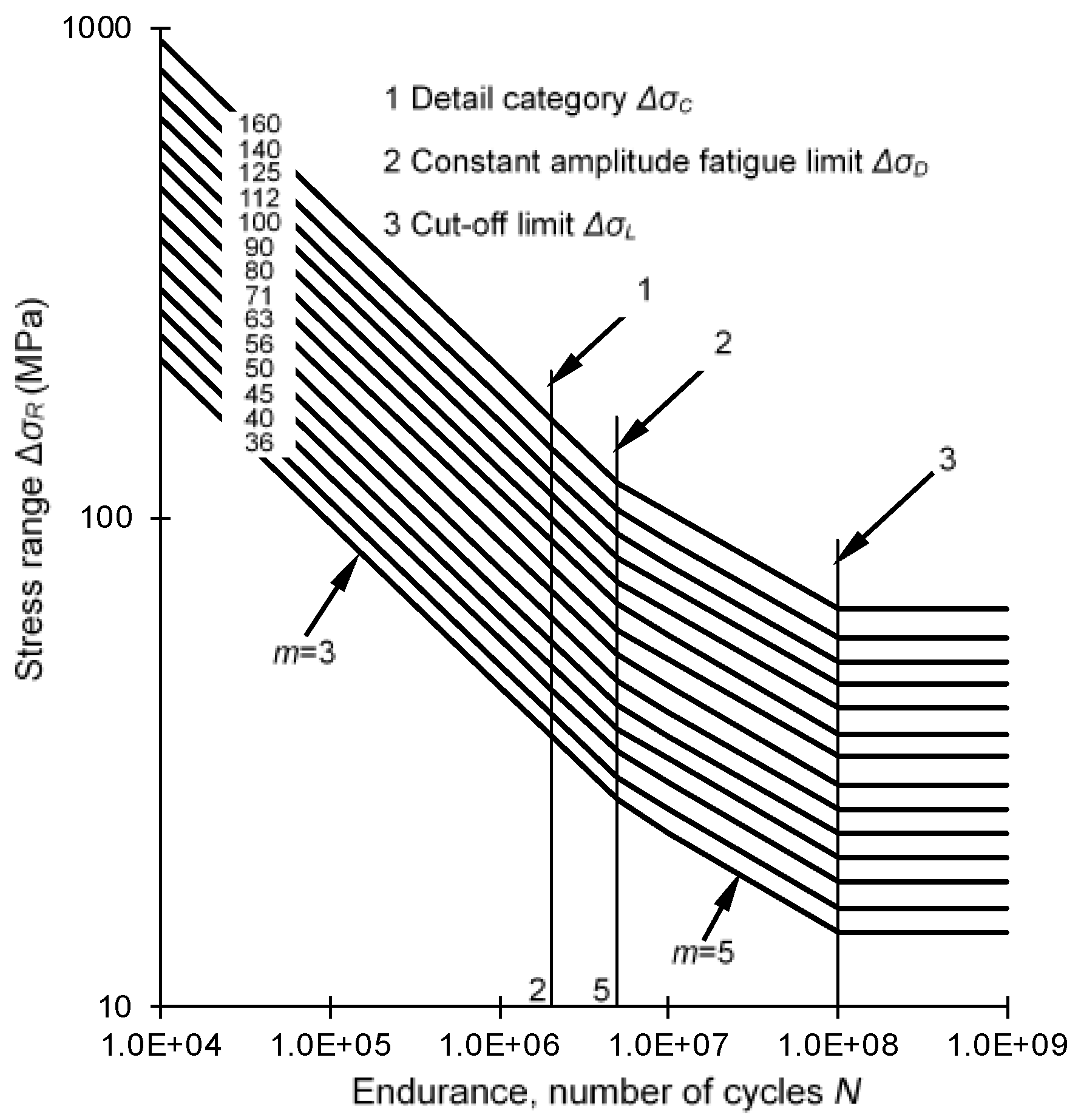


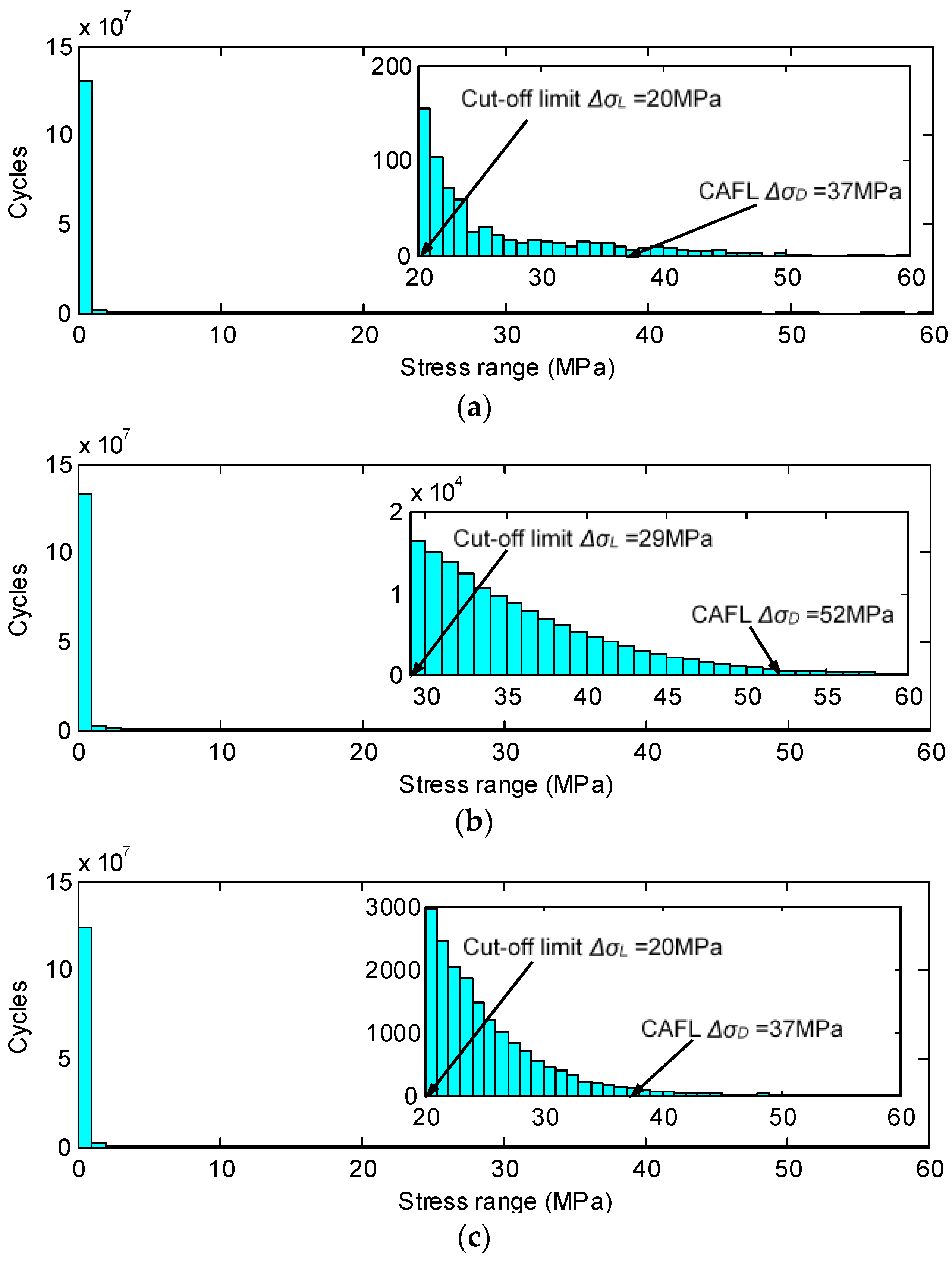
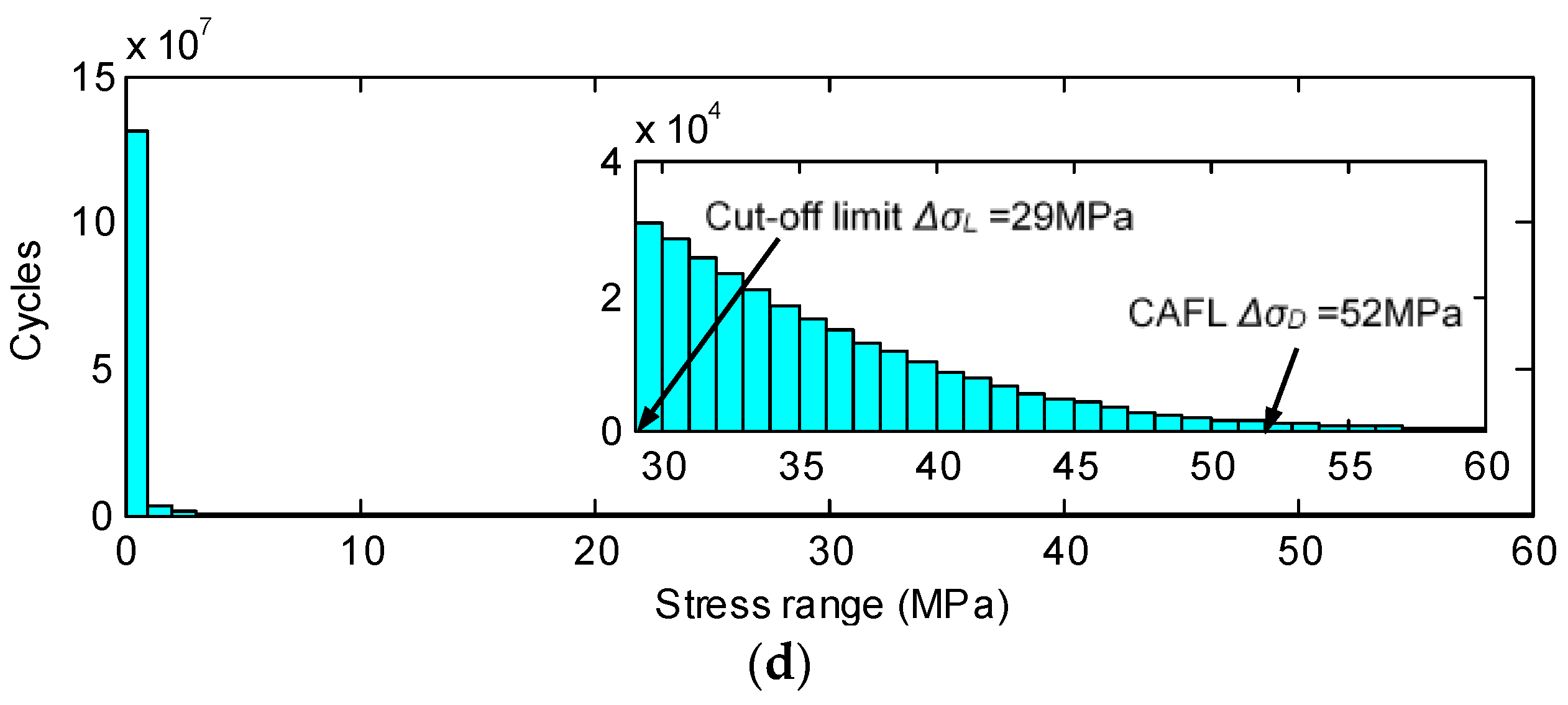

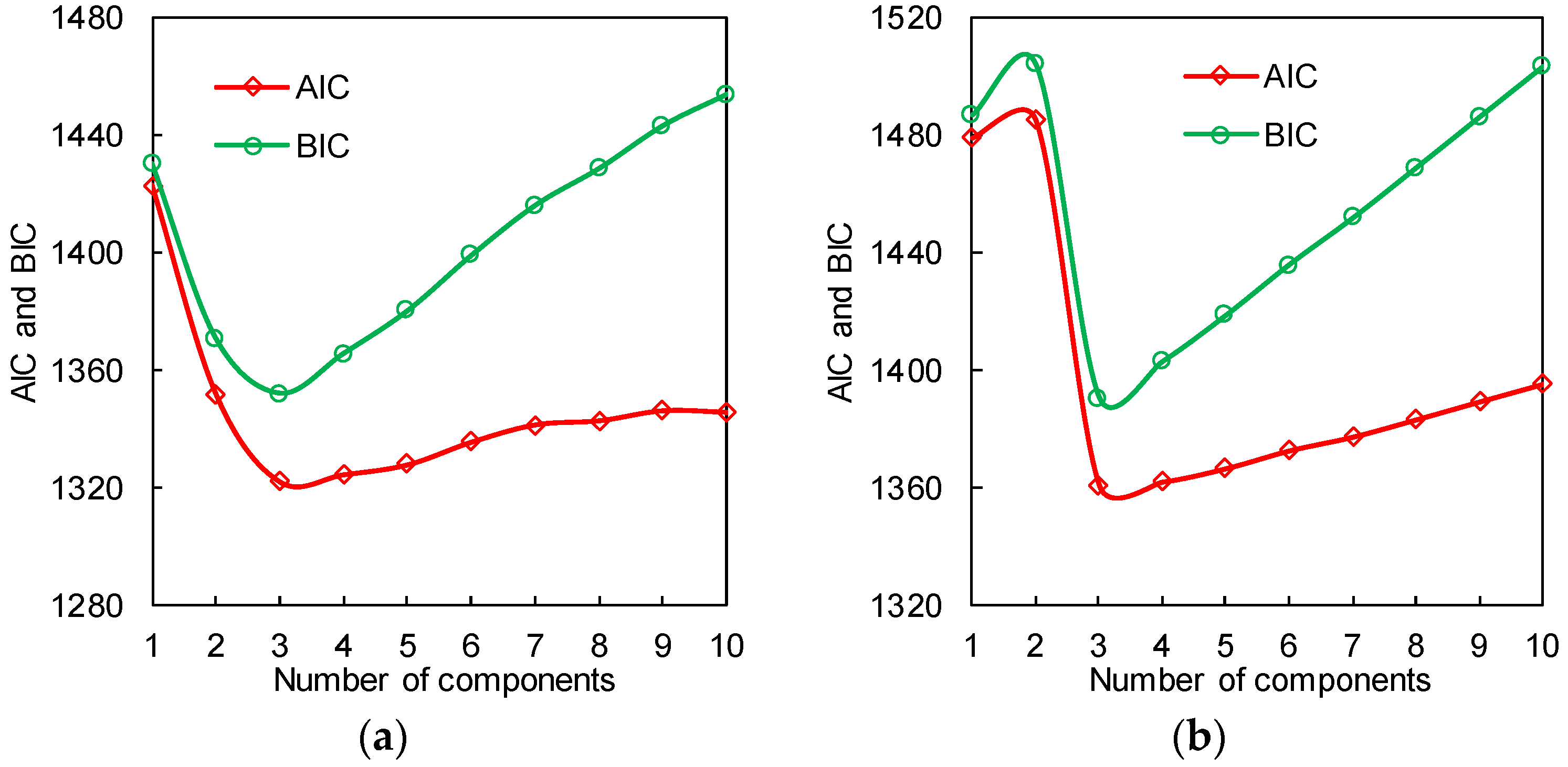
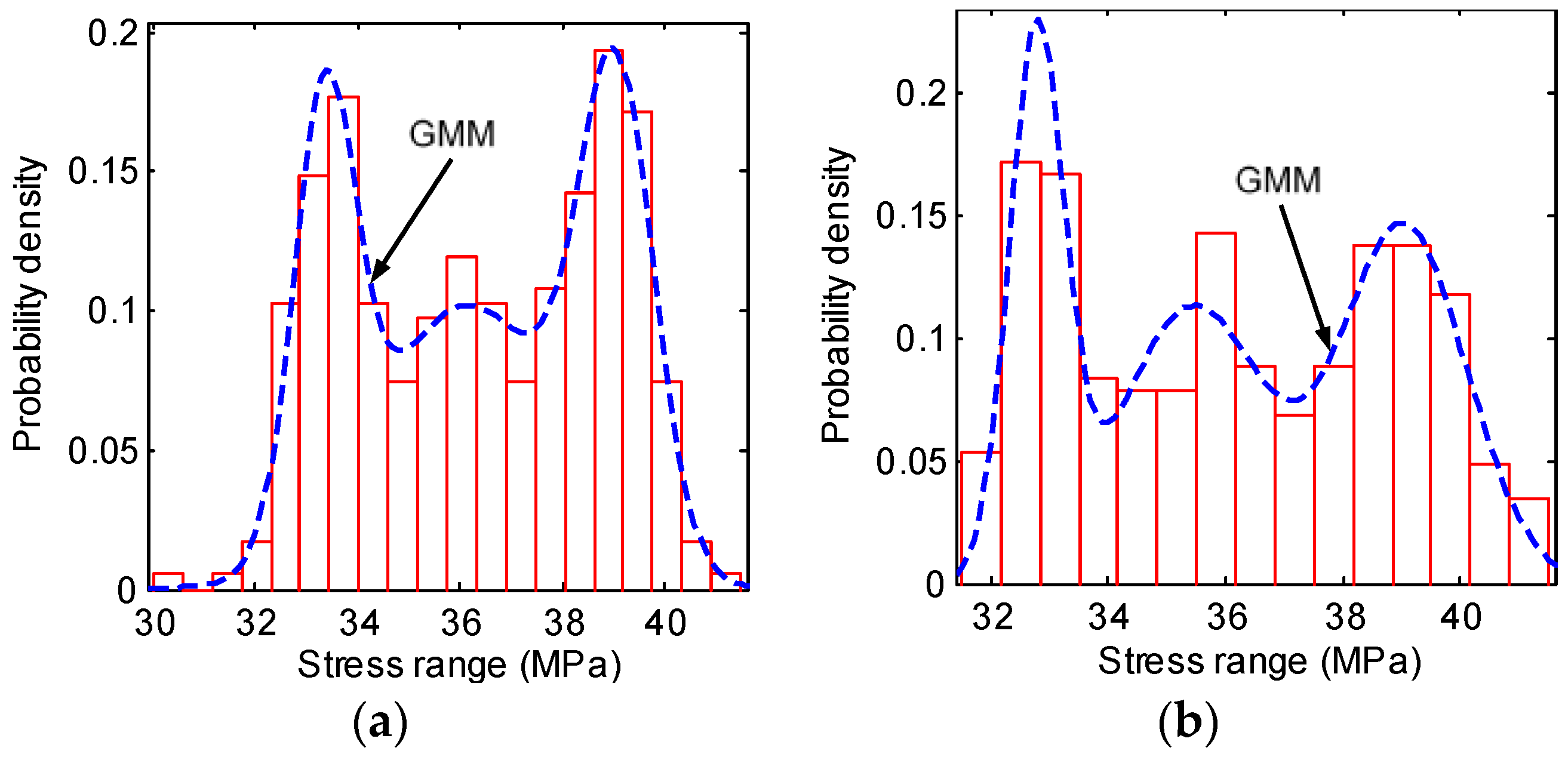

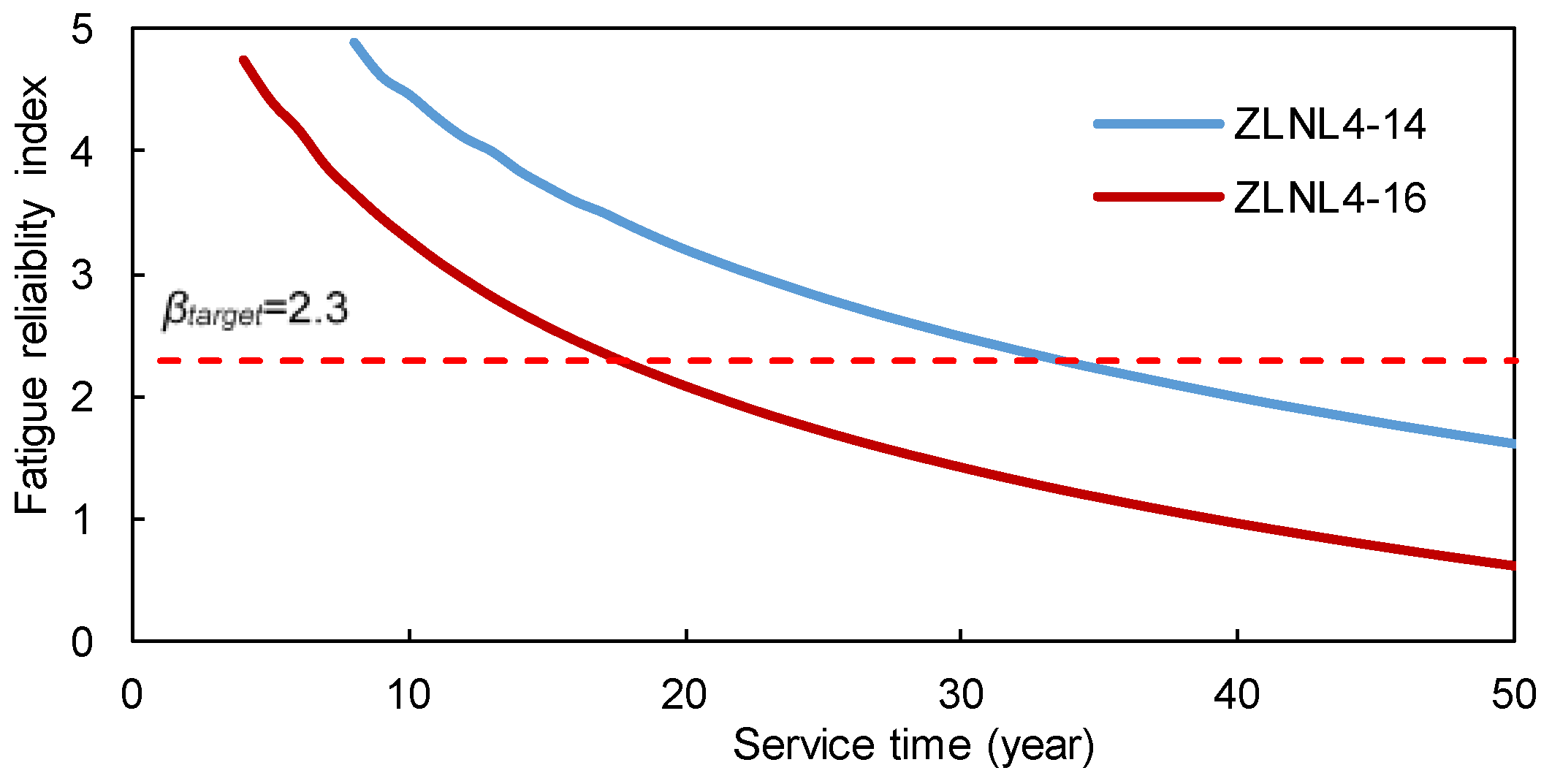
| Description of Welds | Detail Category ΔσC (MPa) | CAFL ΔσD (MPa) | Cut-Off Limit ΔσL (MPa) | Fatigue Strength Coefficient KD |
|---|---|---|---|---|
| Rib-to-deck | 50 | 37 | 20 | 3.47 × 1014 |
| Rib-to-rib | 71 | 52 | 29 | 1.90 × 1015 |
| Random Variable | Description | Distribution Type | Mean Value | COV | Source |
|---|---|---|---|---|---|
| KD | Rib-to-deck | Lognormal | 3.47 × 1014 | 0.45 | Zhao et al. [20], Eurocode 3 [7] |
| Rib-to-rib | Lognormal | 1.90 × 1015 | 0.45 | ||
| Δ | Critical damage | Lognormal | 1.0 | 0.3 | Wirsching [19] |
| e | Measurement error coefficient | Lognormal | 1.0 | 0.03 | Frangopol et al. [17,18] |
| Nc | Accumulated number of stress cycles | Deterministic | - | - | SHM data |
| Welded Details | Total Cycle Number | Cycle Number (Larger than ΔσL) | Cycle Number (Larger than ΔσD) |
|---|---|---|---|
| ZLNL4-13 | 1.319 × 108 | 660.5 | 76.5 |
| ZLNL4-14 | 1.384 × 108 | 143,039 | 2537.5 |
| ZLNL4-15 | 1.276 × 108 | 17,620 | 826.5 |
| ZLNL4-16 | 1.379 × 108 | 270,087 | 5468 |
| Component i | ZLNL4-14 | ZLNL4-16 | ||||
|---|---|---|---|---|---|---|
| wi | μi | σi2 | wi | μi | σi2 | |
| 1 | 0.306 | 39.0 | 0.54 | 0.262 | 32.8 | 0.23 |
| 2 | 0.236 | 33.3 | 0.37 | 0.346 | 35.4 | 1.48 |
| 3 | 0.458 | 36.1 | 3.23 | 0.392 | 39.0 | 1.15 |
© 2018 by the authors. Licensee MDPI, Basel, Switzerland. This article is an open access article distributed under the terms and conditions of the Creative Commons Attribution (CC BY) license (http://creativecommons.org/licenses/by/4.0/).
Share and Cite
Deng, Y.; Li, A.; Feng, D. Fatigue Reliability Assessment for Orthotropic Steel Decks Based on Long-Term Strain Monitoring. Sensors 2018, 18, 181. https://doi.org/10.3390/s18010181
Deng Y, Li A, Feng D. Fatigue Reliability Assessment for Orthotropic Steel Decks Based on Long-Term Strain Monitoring. Sensors. 2018; 18(1):181. https://doi.org/10.3390/s18010181
Chicago/Turabian StyleDeng, Yang, Aiqun Li, and Dongming Feng. 2018. "Fatigue Reliability Assessment for Orthotropic Steel Decks Based on Long-Term Strain Monitoring" Sensors 18, no. 1: 181. https://doi.org/10.3390/s18010181





